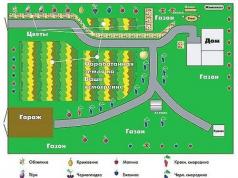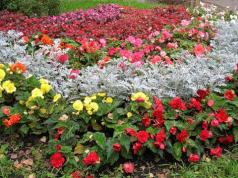09 apr 2017
Ornamental shrubs- an excellent decoration for the garden, they require less care and attention than flowers, the main thing for planting is to make the right choice from the many species and varieties of flowering garden shrubs. Spirea is the most common ornamental shrub in our gardens, since this plant has all the necessary qualities - it is unpretentious to growing conditions, frost resistance, resistance to adverse conditions (drought or rain).
In spirea, depending on the type, thin leafy shoots can grow straight, bend to form a weeping shape, or be arranged in tiers in cascading shrub forms. There are varieties and types of spirea by the size of the bush and the shape of the crown into weeping, cascading, round, spherical, creeping. First of all, depending on the size and shape of the crown, a spirea is chosen to decorate the site, small creeping shrubs will decorate an alpine slide or rockery, medium-sized bushes with a spherical shape are suitable for planting on a lawn, near a reservoir in the background of a mixborder, and tall spireas are often used for creating a green hedge.
The leaves of the spirea on the branches are arranged in pairs, in most species they have an elongated elliptical shape with a pointed tip, but there are varieties with rounded leaves and very small ones. The color of the leaves of the spirea can be with a gray tint, like a gray spirea, have a bright green color, which changes to orange by autumn, there are also decorative deciduous spireas with a yellowish tint of leaves, like the varieties of Japanese spirea "Gold Mound" and "Golden Garpet".

When choosing a spirea, find out how long it will bloom. There are spireas blooming in spring, from about mid-May to early June, or in summer from mid-July to September. Spring-flowering spireas have a predominantly white color of flowers, but the flowering period of spring spireas is usually short 2-3 weeks, in late August - early June they decorate the garden and fill the air with a sweet aroma that attracts bees and other insects. Summer-blooming spireas bloom longer, up to two months, and some from mid-summer to frost, the color of the flowers of these species is predominantly pink, purple and reddish.
The flowers of the spirea are small, about 0.5-1 cm in diameter, with a corolla of delicate petals and bunches of lush stamens with yellow anthers in the center. Spirea flowers are collected from the panicle inflorescence at the ends of the shoots or in scutes, which can form along the entire length of the branches.
Translated from Latin, the name of the Spiraea shrub means "bend". The genus Spirea belongs to the Rosaceae family and has about 80 species of deciduous shrubs that grow naturally throughout the Northern Hemisphere in forests, mountainous regions and steppes. By such a variety of places where spirea grows, one can judge the ability of this plant to adapt to any habitat.

Spirea gray blooms in spring from mid-May, but fades in early June. Blooming gray spirea looks elegant, curved branches cover numerous corymbose inflorescences with snow-white flowers, so the shrub resembles a fountain with white streams. Spiraea is gray unpretentious, frost-hardy, since it blooms on last year's shoots, then pruning and formation of a shrub is carried out later after flowering.

Spirea Wangutta stands out for its impressive size, the height of this shrub can reach 2 meters. The crown of Spirea Vangutta has a cascading spreading shape. White flowers are collected in separate corymbose inflorescences and adorn the shrub in May - June. Spirea Wangutta can be planted in the shade, but it is preferable to choose a sunny place. This shrub will look great in a group of conifers, alone or with a solid wall as a green hedge. This frost-resistant and unpretentious type of spirea reproduces well with green cuttings.

Spirea Thunberg blooms in spring, unlike all spring spirits with white flowers, this species has pink flowers. Dense inflorescences completely cover the spreading drooping branches of the bush. The second feature of Thunberg's spirea is its graceful foliage, which turns bright orange in autumn. The shrub begins to bloom from the age of three and does not exceed 1.5 meters in height.

Spirea willow blooms from July to September, cone-shaped lush inflorescences with white or pink flowers are formed at the ends of the shoots. The spirea willow bush is tall, it grows quickly due to the overgrowth, so this species is often used to create a green wall. Willow spirea is not afraid of even harsh winters; it grows well in a sunny place with fertile, always moist soil.

Spirea Billard forms a large lush round bush, blooms from mid-summer. The ends of the branches are decorated with fluffy inflorescences of a pink-lilac panicle. This type of spirea can winter in the middle lane, but in the spring, after bud break, sanitary pruning is necessary, after bud break, frozen shoots are removed.

Spirea nippolinsky brought to us from Japan, this variety of spirea is distinguished by long flowering in May, when a shrub with emerald greens is covered with snow-white foam from lush inflorescences. Spirea nippolinskaya has a compact size, no more than a meter in height and a neat spherical crown, so this ornamental shrub fits well into perennial flower beds or is used to decorate borders along paths. This shrub is well formed by pruning.

Japanese spirea also comes from the land of the rising sun, but unlike the previous species, it blooms in summer. Japanese spirea has a large number of varieties of different crown sizes, up to 1 meter high or less, color of flowers and leaves. Japanese spirea is hardy, loves sunny places with fertile light soil and is often used in garden compositions with perennial flowers and other ornamental shrubs.
Spirea planting and care:
All types of spirea are unpretentious, require minimal care, regular pruning, they like sunlit places, light fertile soil.
Spirea can be easily propagated by rooting cuttings. Green semi-lignified cuttings are cut in the first half of summer, the lower cut is treated with rooting stimulants and planted in a greenhouse. Rooted cuttings can be replanted to a permanent place next year in spring. Lignified shoots are cut into cuttings in the fall and stored until spring in a cellar or basement, covered with sand. In the spring, when the snow melts, the cuttings are taken out of storage and planted in the ground in a greenhouse or under cover with a film for rooting.
A quick and easy way to propagate spirea is to separate the root suckers. In order for the branches of the bush to give roots, they are pinned to the ground and huddled, after rooting, they are separated from the bush and transplanted.
Spirea seedlings are planted in the fall a month before stable frosts, so that they have time to take root. If you want to plant a spirea in the spring, then you need to be in time before bud break, then the rooting process will go faster and the shrub will start growing more actively.
To plant the spirea, they dig a hole 50-60 cm deep. Coarse sand is poured into the bottom as drainage with a layer of 10 cm. The extracted soil is mixed with humus and complex mineral fertilizer. A mound is poured at the bottom of the pit, the roots of the seedling are spread over it and covered with earth from above to the root collar. To plant spirea seedlings in a row in order to create a green hedge, a trench is dripped in which the seedlings are placed at a distance of about 50 cm, depending on the size of the future crown of the shrub.
The planted spirea seedlings are watered regularly for the first time so that moisture lingers in the soil longer, the trunk circles are mulched and loosened.
It is important to carry out correct pruning in the care of spireas. Spirea pruning differs depending on when your shrub is in bloom.
Spring-blooming spirea blooms on the shoots of last year, so in the spring, after budding, only frozen dry twigs can be removed, since the rest will bloom. Spring spireas are pruned to form a bush immediately after flowering in summer. By the fall, new shoots should grow, which will bloom next year.
Spireas, which bloom in summer, form inflorescences on the shoots of the new season, so in the spring they are completely pruned, the old shoots are shortened by almost half to enhance the branching of the shrub. When pruned in early spring, new shoots will have time to grow and form flower buds by the beginning of flowering in mid-summer.
In the second year, the branches of the spirea no longer bloom, inflorescences will form on its lateral shoots. In order for the flowering of the shrub to be lush every year, it needs to be rejuvenated. Old bushes are pruned under a stump, which stimulates the formation of shoots from the root collar. The next year, 3 to 7 strong shoots are left and a new bush crown is formed from them.








